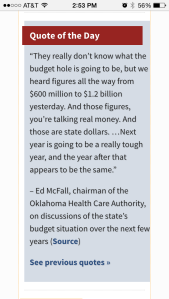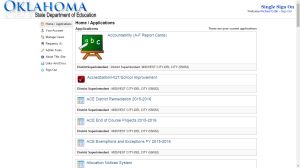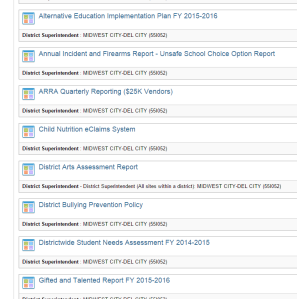With All Due Respect, Vol. 3
This morning, while I was out on a run, my phone was buzzing with friends responding to an editorial written by House Speaker Hickman and published in the Oklahoman today. The piece purports to address the Oklahoma teacher shortage with facts. I seem to have missed some of them, and I’ve read through it three times now.
The first paragraph sets a negative tone. Pretend it’s 2002, you’re in my English II class, and note the author’s diction:
Recent claims that Oklahoma schools can’t fill 1,000 teaching positions have education proponents again demanding the Legislature provide more taxpayer dollars to increase teacher salaries. Education organizations argue that schools are unable to find quality applicants because Oklahoma’s best teachers move to neighboring states to earn more money. Yet Oklahoma’s starting minimum wage for first-year teachers is higher than Texas, Missouri, Arkansas and New Mexico.
The first thing I notice is the word claims. We aren’t claiming anything. We’re reporting the conditions that impact our ability to provide the best possible education to all of Oklahoma’s public school children. We really don’t have the applicants. Next is his use of the phrase taxpayer dollars, which is really all we have access to in schools. During Hickman’s time in the Legislature, state aid for schools has decreased. Later in his editorial, he claims that school funding is at an all-time high. I’d love to know his methodology for that claim.
It’s good to note here, even though it’s not germane to the teacher shortage per se, that the Legislature last spring cobbled together a budget with one-time funds from the cushions of the couch in order to fill a $600 million dollar budget shortfall. Well, it’s happening again. We’ve all been warned – not just education.
The third and fourth paragraphs of Hickman’s piece squarely lay the blame for low teacher salaries on local school boards:
A recent report from the U.S. Department of Education shows it may be because local school boards have committed a growing percentage of their funding to salaries and benefits for administrative and nonteaching staff.
Between 1992 and 2013, enrollment in Oklahoma schools increased by 14 percent while the number of teachers increased by 11 percent. Administrative and nonteaching staff increased by more than 33 percent. If nonteaching staff had increased at only the same rate as enrollment, Oklahoma schools would have nearly $300 million more available annually to pay teachers higher salaries.
The problem with newspaper editorials is that they don’t link to source documents. That’s why I only read them when they’re blowing up my social media accounts. Perhaps the report Speaker Hickman references is actually this report from the Friedman Foundation, which uses data collected by the USDoE. I suspect it is, since Oklahoma’s leading non-profit conservative think tank trots it out from time to time (and since the editorial’s language mirrors that of the report; see page 19), failing to mention that the foundation’s namesake, Milton Friedman, was all about abolishing public schools. In Friedman’s own words:
A radical reconstruction of the educational system has the potential of staving off social conflict while at the same time strengthening the growth in living standards made possible by the new technology and the increasingly global market. In my view, such a radical reconstruction can be achieved only by privatizing a major segment of the educational system–i.e., by enabling a private, for-profit industry to develop that will provide a wide variety of learning opportunities and offer effective competition to public schools. Such a reconstruction cannot come about overnight. It inevitably must be gradual.
Yes, that’s been the political agenda for a segment of conservatives in this state, and in this country, for more than two decades. On the other hand, in the very same paper, Friedman also said this:
If the widening of the wage differential is allowed to proceed unchecked, it threatens to create within our own country a social problem of major proportions. We shall not be willing to see a group of our population move into Third World conditions at the same time that another group of our population becomes increasingly well off. Such stratification is a recipe for social disaster. The pressure to avoid it by protectionist and other similar measures will be irresistible.
Surprisingly, the aforementioned think tank never addresses income inequality, except to dismiss it.
Wow, I’ve really digressed from the main point. That’s what happens when I don’t have much free time to blog.
Sorry, back to Speaker Hickman, who deserves my undivided attention at this point. He was talking about the growth of non-teaching positions. Others have previously pointed out, as I will here, that much of that growth is to help meet ever-increasing state and federal mandates.
Allow me to illustrate. Each school district communicates and reports information through the Single Sign On (SSO) system with the Oklahoma State Department of Education. Different users have different access levels in the system. As a superintendent, I can see them all. The next seven screenshots show them. Indulge me, as I show you why we’ve added staff.
The top of the alphabet has so much of the good stuff: A-F Report Cards; Accreditation (featuring Highly-qualified teacher verification); three separate areas for the Achieving Classroom Excellence morass; and a place to check allocation notices.
Page two starts and ends with routine reporting and plans. Let me point out right in the middle of this page is the District Arts Assessment Report. There are mandates that make me mad (ACE, A-F, RSA) and mandates that just make me want to say, Really!?! (Sorry, Rob – I know that’s your schtick.)
When you click on that report, you see this notice:
As stipulated by Oklahoma law, 70 O.S. § 1210.508, “each school district shall administer to each student in the district in Grades 3-8 an assessment designed to assess the student in the fine arts of visual art and general music.” This method of assessing the arts in Oklahoma public schools has given school districts greater control and flexibility in integrating and assessing the arts in the classroom.
The new online assessment report is similar to the .PDF documents you are used to completing. For each grade that your district serves, data must be entered for at least one Visual Arts standard and one Music standard. Please save each page before going to the next screen or the data will be deleted. Once the report has been submitted, the superintendent will need to certify the report.
This is how some school employees spend their time. One sentence of the instructions is so important, they’ve added emphasis. Twice.
Why are we assessing the arts? If it’s to ensure that students get to experience it, then the moment has passed. I don’t want to audit the amount of time that we spend on the arts in grades 3-8 – in my district or any other. Too often, schools have cut this time (or taken it for remediation) because of the other mandates. In my mind, the logic goes like this: We’ve sucked the soul out of education with all of this testing. Let’s make sure the arts aren’t lost. Let’s test them too! I’ve never ascribed to the if you value it, measure it mentality. You can’t measure love or passion. At one high school’s open house last month, I heard a parent express excitement over her daughter’s love of music. That matters. I value that. I can’t measure it. I won’t try.
Page three is where any of us who have ever managed Federal Programs budgets and plans for a district formed those red spots on our foreheads. They came from hitting our heads on our desks repeatedly while operating in the Grants Management System application. I’m tempted to get more screenshots inside the tab, but trust me – there are just some things that can’t be unseen.
Page four is another place district employees have to spend a considerable amount of time. I personally spent two hours last week signing RSA forms. Some were for retentions. Some were for promotion. If I, as a superintendent, spent two hours just signing and dating papers, how much time was spent by the school and district staff preparing documentation, remediating and retesting students, contacting parents, and meeting as committees?
Page five is just old tabs of school personnel records going back several years. There are a lot of records in there. When you have more than 14,000 students, you have a lot of employees. I know I’ve only been in my new role about six weeks, but I haven’t found one we don’t need yet.
The highlight of page six is the Wave. I even like the logo, although a surfer on an actual wave might have been better. This is where all the student data lives.
All the free/reduced meal data, academic records, online courses, testing, and so forth is stored. I can see this portal, but I’m afraid to enter it. If I do, I might have to read messages like this:
We were having issues sending the STN’s back to local SIS systems earlier in the week, and have corrected the issue. If you are missing STN’s in your system and you have zero students on the STN Wizard please send in a help desk ticket toHelpDesk@omes.ok.gov and we will have them re-published back to your local SIS.
And this:
If on the Data Validation Wizard you are seeing the warning “Lunch Eligibility Determination” was not provided, check the spelling of the word “Determination” in PowerSchool for the SIF agent. If it is missing the letter “a” that is the issue that needs to be corrected. If you have corrected the spelling and still have the same error, be sure to restart your SIF Agent so the change in the spelling can be applied to the agent.
On the last screen, we have a few more reports for Federal Programs and the TLE Reports. Inside of this well of data, I can view the value-added reports for teachers and administrators. Well, I could, but they’re not in there. Or maybe they’re just not loading for me. These things happen.
I’m just fortunate I have great people around me who take care of all of these very detailed reports. They may not be classroom teachers, but their positions are important too.
The Hickman piece continues with a suggestion: just eliminate the minimum teacher salary scale:
Roughly half of states have no statutorily mandated minimum salary for teachers, and it is interesting how they compare to Oklahoma. On our borders, neither Kansas nor Colorado has a mandated salary, yet they pay teachers an average salary of $48,000 and $51,000, respectively, compared with the average salary of $44,000 in Oklahoma. This is basic economics: Mandated minimum salaries restrict wage growth potential. In states where no minimum salary is mandated, schools pay what they feel the market warrants to attract and retain quality teachers. It should also be noted that, unlike Kansas and Colorado, Oklahoma provides health insurance for our education employees.
First – and this always comes up – anyone claiming the average teacher salary in Oklahoma is $44,000 should note that this figure includes insurance and retirement. That means the teachers in Colorado have a larger total compensation package, even though they have to find their own health insurance. For 2015, the health benefit for teachers is $499.42/month – roughly $6,000 per year. Teachers struggling to feed their families – and there are many – get rightly frustrated hearing the larger amount when they know their taxable income is far lower. Eliminate the minimum salary? I don’t think so. It’s a safety net.
I’m still in the same place I’ve been since I began blogging when it comes to the treatment of teachers. It’s going to take serious money to recruit more people into (or back into) the profession. We need higher starting salaries, bigger annual increases, and more of a bump for earning advanced degrees. We need fewer mandates. We need elected leaders who don’t think that testing is how you tell the value of teachers or kids. We need respect for the teachers we have, however they got here.
The shortage is real. These 506 emergency certifications granted at the August SBE meeting aren’t a figment of anyone’s imagination. I should know. I signed the request for several of them.








Wow. What great examples. I think the public at large (including me), and our legislative leaders in particular, are naive to the amount of reporting, documenting and checklisting that goes on in schools. I know those screen shots made me never want the job of a district administrator. I honestly hope Hickman and other will seriously consider the way they are framing our current teacher shortage discussion. Stop the war on teachers and public education.
LikeLiked by 1 person
“Um yeah, I’m gonna need you to come in on Saturday..” Sounds like Office Space! Hard to teach when you are filling out TPS Reports. Lol! If people truly knew how hard teachers, non-teaching staff and administrators work they would be shocked. It’s unreal…and all-consuming. But, we already know that, don’t we? Too bad our legislators don’t!
LikeLiked by 1 person
You know I can’t resist an Office Space reference, Kaycie!
LikeLike
I figured:)
LikeLike
This $44,000 state average . . . I’m in my 15th year with a Master’s and our district scale shows my total salary + retirement at $39,635.50. (Of course, with everything that comes out, I bring home just under 30K/yr.) I’ve been in my building of 30 teachers longer than all but one or two. Where are all these teachers making an AVERAGE of $44,000? I show that I won’t touch that ON PAPER until year 25!
LikeLike
I realize completely why you have not been blogging with as much frequency with your new job as a Superintendent of a 14,000 student school district. But the Oklaed community has missed this type of insightful analysis, Rick. Well done, as always!
LikeLiked by 1 person
Awesome blog! I love the single sign-on pics!!! I have loved reading your blogs for a long time now and was surprised and excited when I read your bio when you took our superintendents job, that you were the author. So glad you are still continuing them. Awesome words. Thank you for advocating for Oklahoma children! Donna Carlberg
Sent from my iPhone
>
LikeLike